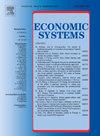宏观经济计量模型中的金融摩擦:以斯洛文尼亚为例的反事实分析
IF 3.3
2区 经济学
Q1 ECONOMICS
引用次数: 0
摘要
本文研究了在斯洛文尼亚小型开放经济的宏观计量经济学框架中模拟金融摩擦影响的重要性。我们用与商业和住宅投资、各自的贷款利率和非金融公司的总营业盈余有关的额外行为方程来增强模型。估计期间从1999Q1到2019Q4,这意味着分析中包括了一段严重的财务困境时期。通过比较具有明确金融摩擦建模的宏观计量经济模型与具有有限传导效应的模型的模拟结果,进行反事实分析。结果表明,在不利的宏观经济情景下,金融摩擦显著阻碍了宏观经济的发展。政策制定者的措施应侧重于维持金融部门的稳定,并使非金融企业和家庭能够在不利的经济形势下获得外部融资。本文章由计算机程序翻译,如有差异,请以英文原文为准。
Financial frictions in a macroeconometric model: A counterfactual analysis for the case of Slovenia
The paper investigates the importance of modelling the effects of financial frictions in a macroeconometric framework for the small open economy of Slovenia. We enhance the model with additional behavioural equations pertaining to business and residential investment, the respective lending rates, and the gross operating surplus of non-financial companies. The estimation period spans from 1999Q1 to 2019Q4, meaning a period of significant financial distress was included in the analysis. Counterfactual analysis was conducted by comparing simulation results from a macroeconometric model with the explicit modelling of financial frictions to a model with limited transmission effects. The results indicate that financial frictions significantly hinder macroeconomic development under adverse macroeconomic scenarios. Policymakers’ measures should focus on maintaining financial sector stability and enabling external financing access for non-financial companies and households during adverse economic situations.
求助全文
通过发布文献求助,成功后即可免费获取论文全文。
去求助
来源期刊

Economic Systems
ECONOMICS-
CiteScore
4.90
自引率
0.00%
发文量
83
审稿时长
48 days
期刊介绍:
Economic Systems is a refereed journal for the analysis of causes and consequences of the significant institutional variety prevailing among developed, developing, and emerging economies, as well as attempts at and proposals for their reform. The journal is open to micro and macro contributions, theoretical as well as empirical, the latter to analyze related topics against the background of country or region-specific experiences. In this respect, Economic Systems retains its long standing interest in the emerging economies of Central and Eastern Europe and other former transition economies, but also encourages contributions that cover any part of the world, including Asia, Latin America, the Middle East, or Africa.
 求助内容:
求助内容: 应助结果提醒方式:
应助结果提醒方式:


